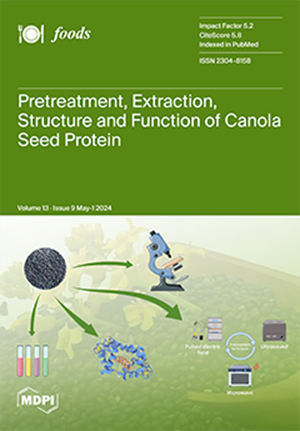韩国松子的可持续动态建模分析:利用近红外光谱的在线学习方法
IF 4.7
2区 农林科学
Q1 FOOD SCIENCE & TECHNOLOGY
引用次数: 0
摘要
由于近红外光谱(NIRS)技术具有快速、无创等优点,已被广泛用于检测坚果食品的营养成分。本研究旨在解决由于韩国松子的储存条件和产地差异等复杂且不可量化的因素而导致离线定量分析模型对不同批次样品产生不理想结果的问题。在离线模型的基础上,利用递归偏最小二乘(RPLS)回归和在线乘法散度校正(OMSC)预处理,提出了一种在线学习模型。这种方法可以利用少量样本数据对原始检测模型进行在线更新,从而提高其泛化能力。OMSC 算法可减少因无法对更新数据集进行有效的散点校正而造成的预测误差。在模型更新过程中,无信息变量消除(UVE)算法会适当增加所选特征带的数量,以扩大潜在相关特征的范围。通过将新的样本特征数据与 RPLS 结合,反复获得最终模型。结果表明,经过 OMSC 预处理后,当特征数量增加到 100 个时,新在线模型对预测集的 R2 值为 0.8945。预测的均方根误差(RMSEP)为 3.5964,明显优于离线模型的 0.4525 和 24.6543。这表明在线模型具有动态和可持续的特点,非常接近实际检测,为检测系统的设计和开发提供了技术参考和方法。它还为坚果食品监管机构和生产企业提供了一种现场快速分析的环保工具。本文章由计算机程序翻译,如有差异,请以英文原文为准。
Towards Sustainable and Dynamic Modeling Analysis in Korean Pine Nuts: An Online Learning Approach with NIRS
Due to its advantages such as speed and noninvasive nature, near-infrared spectroscopy (NIRS) technology has been widely used in detecting the nutritional content of nut food. This study aims to address the problem of offline quantitative analysis models producing unsatisfactory results for different batches of samples due to complex and unquantifiable factors such as storage conditions and origin differences of Korean pine nuts. Based on the offline model, an online learning model was proposed using recursive partial least squares (RPLS) regression with online multiplicative scatter correction (OMSC) preprocessing. This approach enables online updates of the original detection model using a small amount of sample data, thereby improving its generalization ability. The OMSC algorithm reduces the prediction error caused by the inability to perform effective scatter correction on the updated dataset. The uninformative variable elimination (UVE) algorithm appropriately increases the number of selected feature bands during the model updating process to expand the range of potentially relevant features. The final model is iteratively obtained by combining new sample feature data with RPLS. The results show that, after OMSC preprocessing, with the number of features increased to 100, the new online model’s R2 value for the prediction set is 0.8945. The root mean square error of prediction (RMSEP) is 3.5964, significantly outperforming the offline model, which yields values of 0.4525 and 24.6543, respectively. This indicates that the online model has dynamic and sustainable characteristics that closely approximate practical detection, and it provides technical references and methodologies for the design and development of detection systems. It also offers an environmentally friendly tool for rapid on-site analysis for nut food regulatory agencies and production enterprises.
求助全文
通过发布文献求助,成功后即可免费获取论文全文。
去求助
来源期刊

Foods
Immunology and Microbiology-Microbiology
CiteScore
7.40
自引率
15.40%
发文量
3516
审稿时长
15.83 days
期刊介绍:
Foods (ISSN 2304-8158) is an international, peer-reviewed scientific open access journal which provides an advanced forum for studies related to all aspects of food research. It publishes reviews, regular research papers and short communications. Our aim is to encourage scientists, researchers, and other food professionals to publish their experimental and theoretical results in as much detail as possible or share their knowledge with as much readers unlimitedly as possible. There is no restriction on the length of the papers. The full experimental details must be provided so that the results can be reproduced. There are, in addition, unique features of this journal:
manuscripts regarding research proposals and research ideas will be particularly welcomed
electronic files or software regarding the full details of the calculation and experimental procedure, if unable to be published in a normal way, can be deposited as supplementary material
we also accept manuscripts communicating to a broader audience with regard to research projects financed with public funds
 求助内容:
求助内容: 应助结果提醒方式:
应助结果提醒方式:


